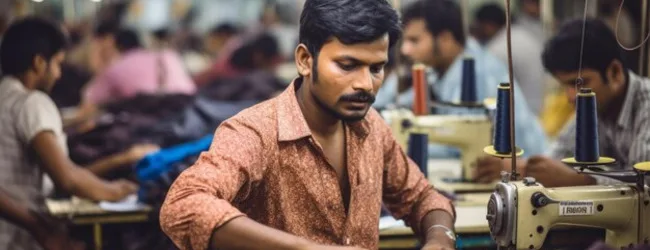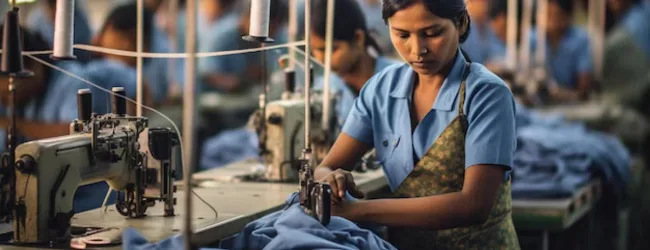Table of contents
- Why to Start a Readymade Garments Manufacturing Business in 2025 ?
- Step-by-Step Guide for Starting a Readymade Garments Manufacturing Business
- 1. Market Research & Niche Identification
- 2. Develop a Comprehensive Business Plan
- 3. Secure Funding & Resources
- 4. Establish Manufacturing Infrastructure
- 5. Legal and Regulatory Compliance
- 6. Marketing and Sales Strategy (Actionable Tactics)
- 7. Technology and Innovation (Future-Proofing Your Business)
- 8. Building a Strong Team (Human Capital)
- 9. Supply Chain Management & Logistics (Optimizing Efficiency)
- 10. Quality Assurance & Control (Building Trust)
- 11. Adaptability & Innovation (Staying Relevant)
- 12. Building a Strong Brand & Customer Relationships (Long-Term Success)
- Conclusion
- Frequently Asked Questions (FAQs)
The Indian apparel market is booming, driven by a growing middle class and increasing fashion consciousness. If you’re looking to capitalize on this trend, knowing how to start a readymade garments manufacturing business in 2025 is crucial. This guide provides a step-by-step approach to help you navigate this dynamic industry and establish a successful venture.
Why to Start a Readymade Garments Manufacturing Business in 2025 ?
- Surging Domestic Demand: India’s rapidly expanding middle class, coupled with rising disposable incomes, is fueling an unprecedented demand for fashionable and affordable apparel. This trend is forecasted to accelerate by 2025, creating a vast market for domestic manufacturers.
- Government Initiatives & Support: The Indian government is actively promoting the textile and apparel industry through various schemes like the Production Linked Incentive (PLI) scheme, and initiatives aimed at boosting exports. These policies are designed to enhance manufacturing capabilities and attract investments, making 2025 a favorable time to enter the sector.
- Evolving Consumer Preferences: Consumers are increasingly seeking personalized, sustainable, and technology-integrated apparel. This shift creates opportunities for businesses that can adapt to these evolving preferences by offering innovative products and services.
- Technological Advancements: The integration of automation, AI, and e-commerce is transforming the apparel industry. By 2025, these technologies will be even more accessible and affordable, enabling businesses to streamline operations, reduce costs, and enhance customer experiences.
- “Make in India” Momentum: The “Make in India” initiative is gaining traction, encouraging domestic production and reducing reliance on imports. This creates a conducive environment for local manufacturers to thrive and expand their market share.
- Growing E-commerce penetration: E-commerce has drastically changed how apparel is sold. By 2025, it is expected that even more of the market will be online, making it imperative that any new clothing manufacturer also has a strong online footprint.
Step-by-Step Guide for Starting a Readymade Garments Manufacturing Business
1. Market Research & Niche Identification

- Analyze Market Trends:
- Data Collection: Use market research reports (like those from Statista, Nielsen, or Indian Textile Industry reports), industry publications, and online trend analysis tools.
- Consumer Behavior: Conduct surveys, focus groups, and analyze social media trends to understand what consumers are buying and why.
- Technological Advancements: Look into automated sewing, 3D printing for pattern making, and online customization platforms.
- Example: Observing the rise of “slow fashion” and ethical consumption, you might notice increased demand for organic cotton and natural dyes.
- Identify Your Niche:
- Niche Selection Criteria: Consider your passion, expertise, available resources, and market demand.
- Niche Validation: Test your niche idea with potential customers through online surveys or small-scale prototypes.
- Example: Instead of general sportswear, focus on yoga apparel made with sustainable bamboo fabrics.
- Competitive Analysis:
- Competitor Profiling: Identify direct and indirect competitors, analyze their strengths and weaknesses, and understand their unique selling propositions (USPs).
- SWOT Analysis: Conduct a SWOT (Strengths, Weaknesses, Opportunities, Threats) analysis of your competitors.
- Pricing Strategy: Compare competitor pricing and determine a competitive pricing strategy.
- Target Audience:
- Demographic Segmentation: Define your target audience based on age, gender, income, location, and lifestyle.
- Psychographic Segmentation: Understand your target audience’s values, interests, and attitudes.
- Buyer Persona: Create a detailed buyer persona to represent your ideal customer.
2. Develop a Comprehensive Business Plan
- Executive Summary:
- Keep it concise and compelling, highlighting your business’s key strengths and potential.
- Company Description:
- Define your legal structure (sole proprietorship, partnership, etc.) and explain your company’s mission, vision, and values.
- Market Analysis:
- Include detailed market size, growth rate, and trends.
- Analyze your target market’s needs, wants, and purchasing behavior.
- Products and Services:
- Provide detailed product specifications, including fabric types, designs, sizes, and quality standards.
- Outline your production process and quality control measures.
- Marketing and Sales Strategy:
- Develop a comprehensive marketing plan, including online and offline strategies.
- Outline your distribution channels, such as retail stores, e-commerce platforms, and wholesale partnerships.
- Financial Projections:
- Create detailed startup cost estimates, including machinery, raw materials, rent, and labor.
- Develop a profit and loss statement, cash flow statement, and balance sheet.
- Include a breakeven analysis.
- Operational Plan:
- Detail your production process, including sourcing, manufacturing, and quality control.
- Outline your supply chain management and logistics.
- Legal and Regulatory Compliance:
- Detail the steps you will take to insure compliance with all applicable laws.
ALSO READ | 10 Highly Profitable Manufacturing Business Ideas Under ₹50,000
3. Secure Funding & Resources
- Identify Funding Sources:
- Government Schemes: Research schemes like the PMEGP, MUDRA loans, and CGTMSE.
- Venture Capital/Angel Investors: If you have a unique or innovative product, consider seeking venture capital or angel investment.
- Crowdfunding: Platforms like Kickstarter and Indiegogo can be used to raise funds.
- Estimate Startup Costs:
- Create a detailed spreadsheet of all startup costs.
- Obtain quotes from multiple suppliers for machinery and raw materials.
- Financial Planning:
- Develop a realistic budget and cash flow projections.
- Monitor your expenses and revenue closely.
4. Establish Manufacturing Infrastructure

- Location Selection:
- Consider factors like labor costs, transportation costs, and proximity to raw materials.
- Visit potential locations and assess their suitability.
- Machinery & Equipment:
- Invest in quality machinery that meets your production needs.
- Consider leasing or buying used equipment to reduce costs.
- Raw Material Sourcing:
- Establish relationships with reliable suppliers who can provide consistent quality and timely delivery.
- Negotiate favorable payment terms.
- Quality Control:
- Implement a quality management system (QMS) to ensure consistent product quality.
- Train your workers on quality control procedures.
- Labor Management:
- Comply with all labor laws and regulations.
- Provide a safe and comfortable working environment.
💡 Pro Tip: If you want to start a Manufacturing Business but have too many doubts, connect with a Manufacturing Business expert from Boss Wallah for guidance – https://bw1.in/1116
5. Legal and Regulatory Compliance
- Business Registration:
- Choose the appropriate legal structure for your business.
- Register your business with the Registrar of Companies (ROC).
- Licenses and Permits:
- Obtain a factory license from the local municipality.
- Obtain a trade license from the local authorities.
- Register for GST.
- If exporting, obtain an Import Export Code(IEC).
- Labor Laws:
- Comply with the Minimum Wages Act, Factories Act, and other labor laws.
- Environmental Regulations:
- Comply with all environmental regulations related to waste disposal and pollution control.
- Product Safety Standards:
- Ensure your products meet relevant safety standards, such as those set by the Bureau of Indian Standards (BIS).
6. Marketing and Sales Strategy (Actionable Tactics)
- Branding and Marketing:
- Develop a strong brand identity, including a logo, tagline, and brand story.
- Create a website and social media profiles.
- Online Presence:
- Utilize SEO to improve your website’s search engine rankings.
- Run targeted social media advertising campaigns.
- Use influencer marketing.
- Offline Channels:
- Participate in trade shows and exhibitions.
- Establish relationships with retailers and distributors.
- E-commerce:
- Create an online store on your website or partner with e-commerce platforms.
- Offer multiple payment and shipping options.
- Wholesale & Retail:
- Create a wholesale price list.
- Develop good relationships with retailers.
7. Technology and Innovation (Future-Proofing Your Business)

- Automation:
- Invest in automated sewing machines and cutting equipment.
- Implement inventory management software.
- E-commerce and Digital Marketing:
- Use data analytics to track customer behavior and optimize your marketing campaigns.
- Utilize CRM software.
- Sustainable Practices:
- Use eco-friendly materials and production methods.
- Reduce waste and recycle materials.
- Customization:
- Offer online customization tools to allow customers to design their own garments.
- AI & Data Analytics:
- Use AI to predict trends.
- Use data analytics to refine marketing.
8. Building a Strong Team (Human Capital)
- Hire Skilled Professionals:
- Recruit experienced designers, pattern makers, and sewing operators.
- Conduct thorough interviews and background checks.
- Training and Development:
- Provide ongoing training to your employees.
- Invest in employee development programs.
- Foster a Positive Work Environment:
- Create a culture of respect and collaboration.
- Offer competitive salaries and benefits.
9. Supply Chain Management & Logistics (Optimizing Efficiency)
- Sourcing Strategies:
- Diversify your suppliers to mitigate risks.
- Explore ethical and sustainable sourcing options.
- Establish long-term relationships with key suppliers.
- Inventory Management:
- Implement an inventory management system to track stock levels and prevent shortages or overstocking.
- Use forecasting techniques to predict demand.
- Consider just-in-time inventory management.
- Logistics & Distribution:
- Choose reliable transportation and logistics partners.
- Optimize your distribution network to reduce costs and delivery times.
- Utilize technology for tracking and managing shipments.
- Warehousing:
- Ensure adequate storage space for raw materials and finished goods.
- Implement proper storage and handling procedures.
- Consider 3PL (Third Party Logistics) for efficient storage and shipping.
10. Quality Assurance & Control (Building Trust)

- Establishing Standards:
- Define clear quality standards for your products.
- Implement quality control procedures at every stage of the manufacturing process.
- Adhere to relevant industry standards and certifications.
- Inspection & Testing:
- Conduct regular inspections of raw materials and finished goods.
- Use testing equipment to ensure product quality.
- Implement a system for tracking and resolving quality issues.
- Customer Feedback:
- Solicit customer feedback to identify areas for improvement.
- Address customer complaints promptly and professionally.
- Use customer feedback to improve product design and quality.
- Traceability:
- Implement systems to allow for product traceability, especially for sustainable or organic goods.
11. Adaptability & Innovation (Staying Relevant)
- Embracing Technology:
- Stay up-to-date with the latest technologies in the apparel industry.
- Invest in automation and digital tools to improve efficiency and reduce costs.
- Explore 3D design and virtual prototyping.
- Sustainability:
- Adopt sustainable practices to reduce your environmental impact.
- Use eco-friendly materials and production methods.
- Promote ethical labor practices.
- Flexibility:
- Be prepared to adapt to changing market conditions and consumer preferences.
- Develop a flexible production system that can accommodate small and large orders.
- Consider offering custom made clothing.
- Evolving Business Models:
- Consider direct-to-consumer sales.
- Explore subscription based clothing models.
- Leasing or renting clothing.
12. Building a Strong Brand & Customer Relationships (Long-Term Success)

- Brand Storytelling:
- Create a compelling brand story that resonates with your target audience.
- Communicate your brand values and mission.
- Build a strong brand identity.
- Customer Service:
- Provide excellent customer service to build loyalty.
- Respond to customer inquiries and complaints promptly.
- Offer personalized service.
- Community Building:
- Engage with your customers on social media.
- Create a community around your brand.
- Host events and workshops.
- Loyalty Programs:
- Implement customer loyalty programs.
- Offer exclusive discounts and promotions.
Need Expert Guidance?
Starting a business can be challenging, but you don’t have to do it alone! At Boss Wallah, our 2,000+ business experts are ready to provide valuable insights and guidance. Whether you need help with marketing, finance, sourcing, or any other area of any business, our business experts are here to help you succeed- https://bw1.in/1116
Confused about Which Business to Start?
Want to start your own business but unsure which one to choose? Explore Boss Wallah, where you’ll find 500+ courses by successful business owners, featuring practical, step-by-step guides on starting and growing various businesses. Find your perfect business idea today – https://bw1.in/1111
Conclusion
Starting a readymade garments manufacturing business in 2025 requires careful planning, market research, and execution. By focusing on a niche, developing a strong business plan, and leveraging technology, you can create a successful and sustainable business. Remember to stay adaptable to the ever-evolving market trends and prioritize quality and customer satisfaction.
Frequently Asked Questions (FAQs)
1 . What is the minimum investment required to start a readymade garments manufacturing business?
- The investment varies depending on the scale of operations, location, and equipment. It can range from ₹5 lakhs to ₹50 lakhs or more.
2 . What are the key licenses and permits required?
- Business registration, factory license, trade license, GST registration, and environmental clearances.
3 . How can I find reliable raw material suppliers?
- Attend textile exhibitions, connect with industry associations, and research online directories.
4 . What are the popular niches in the Indian apparel market?
- Children’s wear, ethnic wear, sportswear, sustainable fashion, and plus-size clothing.
5 . How can I market my products effectively?
- Utilize online platforms, social media marketing, e-commerce, and offline channels like retail stores and exhibitions.
6 . What are the challenges in starting a readymade garments business?
- Competition, raw material sourcing, labor management, and maintaining quality standards.
7 . How can I ensure quality control in my manufacturing process?
- Implement strict quality checks at every stage, use high-quality materials, and train your workers.
8 . How can I leverage technology in my business?
- Automate processes, use e-commerce platforms, implement inventory management systems, and utilize data analytics.


